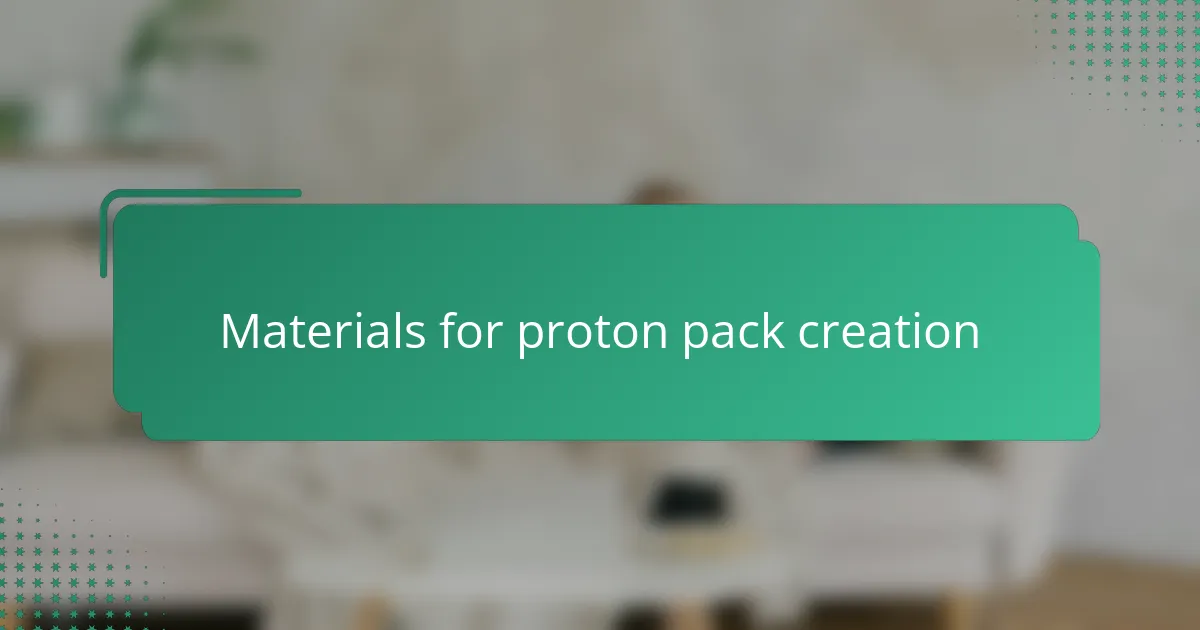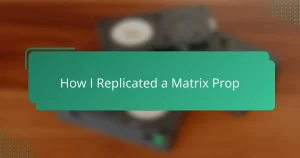Key takeaways
- Science fiction props serve as creative gateways, blending imagination with technical skill to enhance storytelling.
- Utilizing the right tools and materials is essential for effective prop building, impacting comfort and authenticity.
- Finishing touches like weathering effects and attention to detail transform a prop from basic to movie-set quality.
- Displaying and using the prop thoughtfully can create a deeper connection to the fictional world it represents.

Understanding science fiction props
Science fiction props are more than just quirky objects on a set—they are gateways into other worlds. I’ve always been fascinated by how a simple prop can spark the imagination, making the unbelievable feel tangible. Have you ever picked up a carefully crafted prop and suddenly felt transported into the universe it belongs to?
From my experience, understanding these props means appreciating the blend of creativity and technical skill behind them. It’s like decoding a language: every detail, from materials to textures, tells a story about the fictional world and its rules. Don’t you find it intriguing how something plastic or metal can evoke emotions and memories as strongly as any character?
What truly fascinates me is the way science fiction props push the boundaries of what’s possible. They challenge makers to invent, innovate, and sometimes even guess how future technologies might work. This mix of imagination and craftsmanship makes diving into their construction not just a project, but an exploration of dreams turned real.

Essential tools for prop building
When I started building my Ghostbusters proton pack, I quickly realized that having the right tools makes all the difference. Simple items like a rotary tool and a precision screwdriver became my best friends—they gave me the control I needed to shape tiny details without frustration. Have you ever tried to work on something delicate without the proper instruments? It’s like trying to paint a masterpiece with a broom.
Power tools aside, I found that having measuring tape and a good set of files were essential for achieving that perfect fit and finish. These little tools helped me refine edges and smooth surfaces, turning rough cuts into something that looked professionally crafted. It’s amazing how a small change here and there can elevate a prop from “homemade” to “screenworthy.”
Of course, no prop builder should underestimate the value of a solid workspace equipped with clamps and a reliable glue gun. Holding pieces steady while adhesives set is crucial, and I remember more than once having to redo sections simply because my workspace wasn’t organized enough. Does anyone else get that mix of excitement and nerves when assembling those intricate components? That’s when your tools truly become your safety net.

Materials for proton pack creation
Gathering the right materials was the first big step in building my proton pack. I remember feeling a mix of excitement and overwhelm as I sifted through plastic sheets, foam, and various metals, wondering which combination would best mimic the original prop’s intricate look. Have you ever stood in front of a hardware store aisle, unsure if PVC pipes or acrylic rods will bring your creation to life? That’s exactly the kind of choice that shapes the entire project.
One thing I learned early on is that not every material has the same magic. Lightweight plastics became my go-to because they balance durability with comfort—I didn’t want to be lugging around a heavy pack for hours. Meanwhile, bits of aluminum and wiring added that authentic industrial feel, making the pack look like it came straight from Ghostbusters headquarters. It’s fascinating how mixing everyday items with specialty materials can create something that truly captures imagination.
What really surprised me was how small details, like choosing a specific type of paint or weathering technique, depend heavily on the base materials you start with. The foam I used for some components soaked up paint differently than the plastic parts, forcing me to adapt my approach on the fly. Have you ever had to rethink your entire finishing process because the materials behaved unexpectedly? Those moments, though challenging, make the build feel alive—as if the prop has its own personality guiding you forward.

Step by step proton pack assembly
Starting the assembly of the proton pack felt like piecing together a complex puzzle. I began by carefully aligning the frame pieces, using clamps to hold everything steady while I secured them with screws and glue. Have you ever noticed how, in projects like this, patience becomes as important as precision?
Next came the detailed work—attaching the various tubes, wires, and lights that give the pack its iconic look. I found that working in small sections made the process less overwhelming, allowing me to focus on getting each component just right. Don’t you think that slowing down at these moments helps the whole prop come alive?
Finally, wiring the LEDs and ensuring everything was connected properly was both thrilling and nerve-wracking. Testing each light and sound component felt like bringing a piece of fiction into reality. I remember holding my breath the first time it powered on—did it work as I imagined, or was I missing a crucial connection? Moments like that remind me why this build is so rewarding.

Tips for finishing and detailing
Finishing a proton pack is where the magic really happens. I found that applying multiple thin layers of paint, rather than one thick coat, gave me much better control over the color and texture. Have you ever tried rushing this step, only to end up with drips or uneven patches? Taking my time here made the details pop and gave the pack a more authentic, weathered look.
Adding weathering effects can be intimidating at first, but it’s where your prop starts to tell a story. I like to use a mix of dry brushing and subtle washes to mimic dirt and wear—techniques that aren’t hard but require patience and a gentle hand. When I stepped back after the first wash and saw how the grime settled into the crevices, it felt like my proton pack had lived through ghostbusting adventures already.
Don’t underestimate the power of small details like decals, labels, and wiring tidiness. I remember spending extra time hand-painting tiny symbols and carefully routing wires because those finishing touches pulled everything together. It’s amazing how these little extras can turn a good prop into something that looks like it belongs on a movie set. Have you ever noticed how attention to detail can make all the difference?

Personal challenges and solutions
One of the biggest challenges I faced was figuring out how to make the proton pack both lightweight and sturdy. Early on, I realized that some materials I picked made the pack too heavy to wear comfortably for more than a few minutes. Have you ever built something only to find it feels like a burden when you try to use it? Switching to lighter plastics and reinforcing key areas with aluminum was my solution—balancing strength without sacrificing comfort.
Another hurdle was managing the complexity of the wiring and electronic components. I remember feeling overwhelmed staring at a tangle of wires, unsure where to start. Breaking down the circuit into smaller sections and labeling each wire helped me stay organized and prevented countless headaches. Don’t you find that a bit of planning often saves hours of frustration?
Lastly, I struggled with perfecting the paint finish to capture that realistic, weathered look. My first few attempts looked too glossy or flat, lacking the depth I wanted. Experimenting with different layering techniques and practicing patience made all the difference. It’s funny how something as simple as letting paint dry between coats can transform a project from amateur to authentic-looking. Have you ever been surprised how much finishing touches can elevate your work?

Display and usage ideas
Displaying my proton pack is like sharing a piece of the Ghostbusters universe with visitors—the best spot, I found, is on a sturdy wall mount near eye level, where the details really catch the light and spark conversations. Have you ever noticed how props, when properly showcased, almost tell their own story without you saying a word? I love how this pack becomes a centerpiece, inviting questions and admiration.
When it comes to usage, I often wear the pack during fan conventions and costume events, which is thrilling but also a little nerve-wracking at first. Balancing comfort with the desire to show off every quirky gadget taught me the value of lightweight construction. How often do we find that having a prop just for display isn’t enough—that feeling of wearing it, moving around, really connects us to the fictional world?
Sometimes, I get creative and integrate the pack with subtle LED lighting effects powered by small battery packs, adding that extra spark of realism without the hassle of complex wiring. Simple touches like this have made my props not just objects, but experiences. Have you experimented with making your props interactive? Those moments of engagement can transform a static display into something truly memorable.


